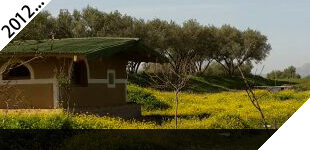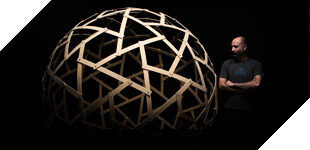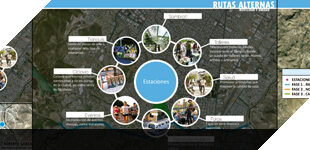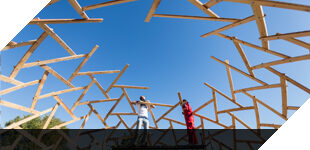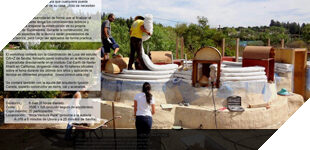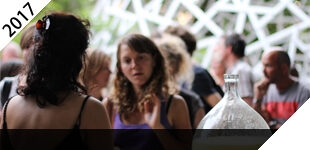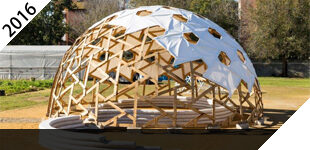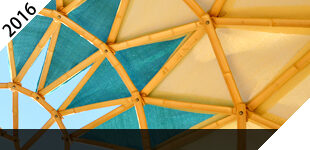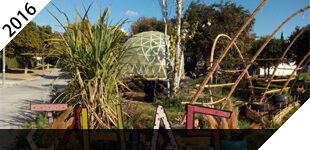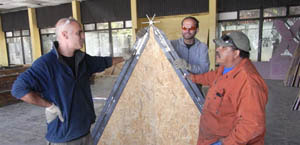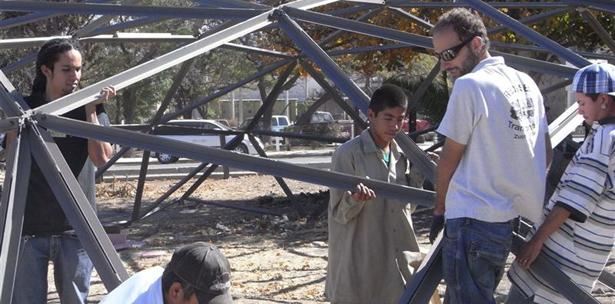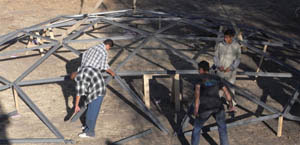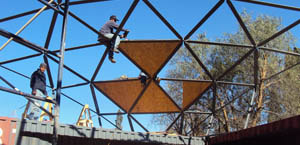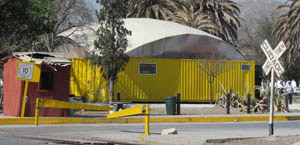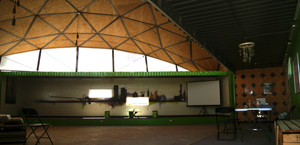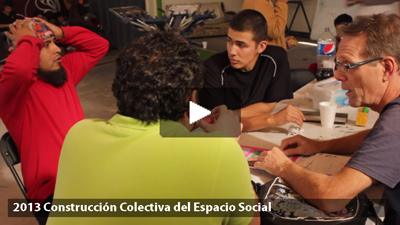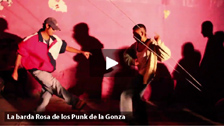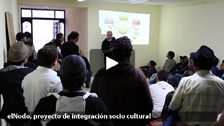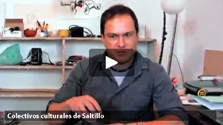>>>>>>>
elNodo – Participatory Cultural Center
ATTENTION: THIS PROJECT IS THE RESULT OF A COLLABORATIVE PROCESS BETWEEN CTRL+Z AND DIFFERENT ACTORS. TO UNDERSTAND IT CORRECTLY I INVITE YOU TO GET CLOSE TO THE OTHER DIRECTLY INVOLVED SUBJECTS: A.C. EL NODO (SALTILLO), LAMATRAKA (SEVILLA), STRADDLE3 (BARCELONA).
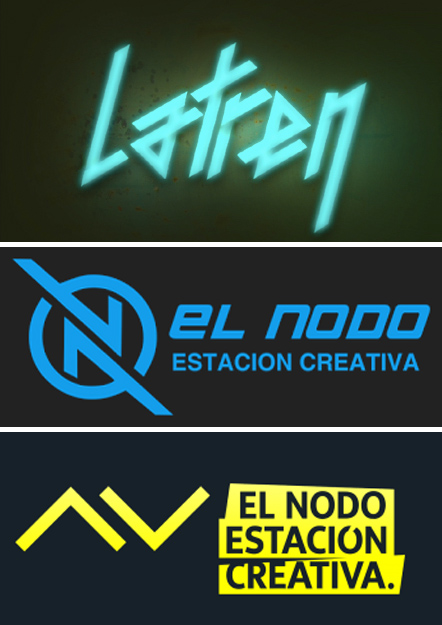 laTren / elNodo cultural center
laTren / elNodo cultural center
laTren / elNodo is a training and cultural production facility that aspires to be an intermediary and bounding element between the disintegrated, disconnected or marginalized neighborhoods in the city of Saltillo. It proposes a participatory center concept, open to the direct proposals of citizens, and hence different from the traditional of the institutional cultural centers.
The center is developed in such a way that, in the construction and cultural production process, individuals and collectives will be the protagonists, and want to be, more than an exhibition space, a production space where, from the concerns of the neighborhood and involved citizens, programs of training and creativity could emerge, thereby promoting feelings of belonging and civic pride.
* The center had different names, eventually at its inauguration was provisionally set as “laTren”, but then again became “elNodo” coinciding with the name of the cultural association that runs it.
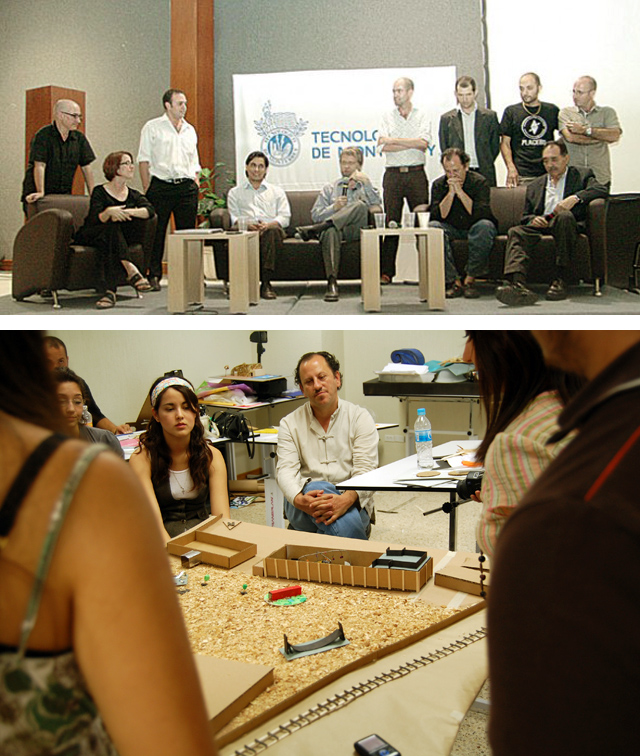 Background: 2009 CiudadX Forum
Background: 2009 CiudadX Forum
The idea of the cultural equipment elNodo starts to germinate in August 2009 during the celebration of the “Ciudad X” forum organized by Fernando Carrera to which I participated. Fernando, inspired by the experiences he had known during his studies in Europe, aimed to bring socio-cultural equipments to the marginal neighborhoods of his city, Saltillo.
Therefore he decided to gather, with “Ciudad X”, national and international experts to discuss around urban industrial tissues recovery experiences for their transformation into cultural equipments.
Together with the forum a 5 days workshop was also organized to suggest proposals with students. Despite the brevity of this event among the participants an atmosphere of enthusiasm was created and at its end the real possibility of performing the developed proposals raised. Thus the seed of cultural facilities elNodo was planted.
Back to Sevilla the enthusiasm was still alive and for the next six months the work in constant contact with Fernando continued for the preparation of a solid and concrete proposal.
2010 Project and construction
In March 2010 I traveled back to Saltillo, accompanied by other professionals, to work alongside with Fernando in the constitution of a local team, consisting in the beginning mainly of college students, for the construction and future management of the physical and mental space of the cultural center. Fernando had begun to structure the initiative constituting the “Civil Association elNodo” whose main objective was the opening of spaces of opportunity in the most deprived, with higher poverty, unemployment and lacking of public spaces rates, areas of the city.
Finally in July 2010 all the produced work paid off obtaining the use of the former railway station of Saltillo, closed in 1997, and SEDESOL and Cemex support.
ATTENTION: This short film was realized collectively as part of the 2nd laTren’s documentary workshop directed by Reginaldo Chapa.
From the beginning the elNodo workteam, which we integrated, knew that the construction of the mental space was even more important than the construction of physical one. Create a community linked, participative and co-responsible with the project was essential to bring to fruition the work and above all to impregnate it with resilience and with all the necessary aptitudes to endure in time beyond our presence.
Therefore briefings, assemblies, working or support committees for joint projects were held along with a permanent office for consultation, proposals or meetings.
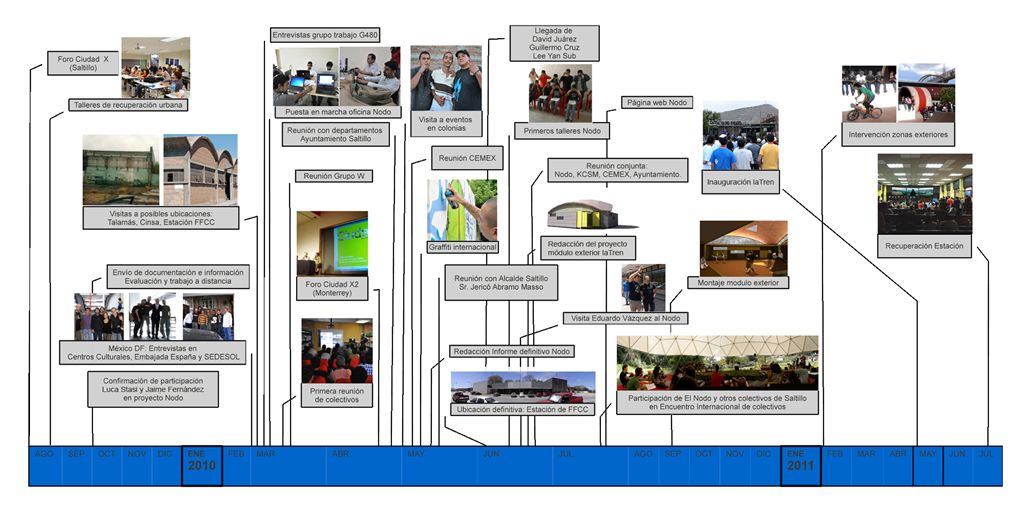 From these meetings raised elNodo whose ultimate goal was to provide the people from nearby neighborhoods and cultural collectives with the necessary tools for independent production, with ongoing advice (logistical and financial) for their proposals.
From these meetings raised elNodo whose ultimate goal was to provide the people from nearby neighborhoods and cultural collectives with the necessary tools for independent production, with ongoing advice (logistical and financial) for their proposals.
Despite not having its own physical space, elNodo cultural activities began in June 2010 with free workshops and courses for youth from marginal neighborhoods and of all around the city, contributing to their training and integration.
These workshops, in addition to working on the center creation process specific needs, served as a first step in implementing local, national and international, relations with cultural organizations and with funding institutions. Importantly, the different stages of process definition and implementation where developed in a workshop scheme, leaving a well of knowledge to empower citizens in facing the further development of this and other projects.
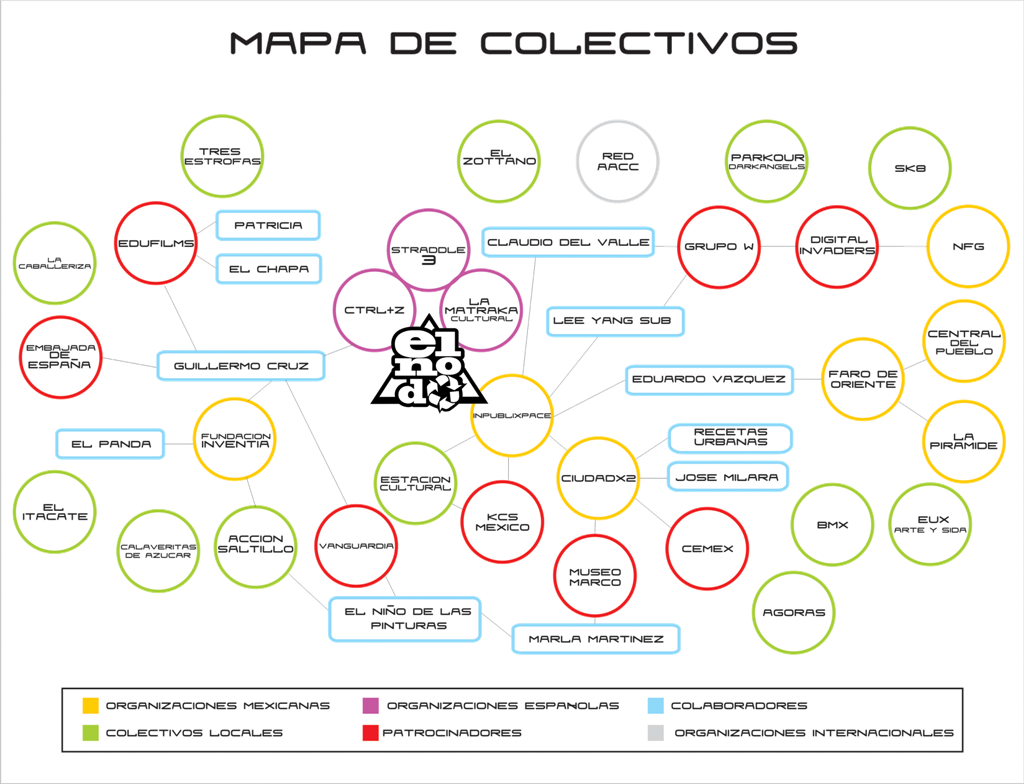
Once this initial stage ended, Ctrl+Z remained in Saltillo to articulate together with A.C.elNodo the construction phase.
Finally, during the months of November and December 2010, the first self-built workshop was developed, it was managed with David of Straddle3 (meanwhile Jordi dealt from abroad with the structure calculation).
The workshop has also counted on the cooperation of NoSoloPaja for carpentry’s module and of “El Panda” as social mediator for a better integration of young people of the nearby neighborhoods in the process.
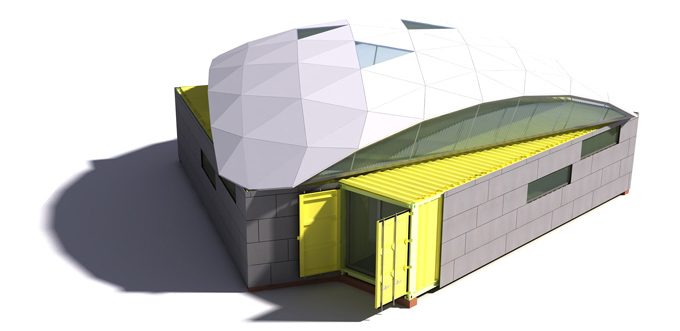
 People of very diverse origin where involved in the workshop, from neighbors of the colonies located around the center, including teenagers from the local gangs environment, students and young professionals.Local professionals joined the team for more complex and risky tasks.
People of very diverse origin where involved in the workshop, from neighbors of the colonies located around the center, including teenagers from the local gangs environment, students and young professionals.Local professionals joined the team for more complex and risky tasks.
The aim was to build a first equipment (150 m2), the first step of an integral project for the recovering of the railway station and its surrounding areas for sociocultural purposes.
Regarding the constructive aspects, although the fibercement curtain walls were never installed, the interior temperature results pleasant even under the northern Mexico’s harsh sun, confirming the validity of the proposed bioclimatic strategy. It was based on a large central thermal mass (concrete floor) and the domed roof. The first, being protected from direct sunlight, contributes to regulate and maintain the internal temperature constant, while the second promotes airflow and allows the output of the heated indoor air above the containers where a suction effect is created. Furthermore the complex was also configured and oriented in a way in which the hot sun alternately hit the different containers, so that there is always a cooling down container protected by its own or roof’s shade.
In December 2010 the equipment is left of the AC elNodo and to Saltillo’s collectives (Acción Saltillo, La Caballeriza, Edufilm…) that finalize the construction and start up with the socio-cultural programming for which it was intended. Finally on July 18 2011 the official opening was held organized by the center’s collectives and social workers.
The whole process had several supporters, among which we must highlight the financial support of SEDESOL (Ministry of Social Development, Federal Government), the transfer of the railway station and materials donation of Kansas City Southern of Mexico and logistics and material support from Cemex. We hope that both groups and institutions involved as well as aid programs for the project may be extended in the forthcoming phases.
It is very difficult to summarize a process that has been developed over nearly twenty months along which different individuals, associations and institutions have been incorporating and disappearing and that is still very much alive after our return to Europe articulating and reconfiguring again and again. Every contribution, although punctual, must be considered essential in the context of the overall process. The following credits are referring exclusively to the period of our stay in Mexico, these do not relate to current management that’s carried out successfully independently of us:
The independent Cultural Center elNodo / laTren is an initiative promoted by A.C.“elNodo” (Fernando Carrera, Fernanda Zetina and later Gabriela Dávila), designed by Ctrl+Z (GianLuca Stasi) and Straddle3 (David Juarez) with cultural development by lamatraKa (Jaime Fernández), and included the timely collaboration of Manuel Rodríguez (Urban Planner), Jordi Granada (Structures) and NoSoloPaja (Michele Pecoraro) for in situ selfbuilding and the close collaboration of Action Saltillo (Lyj González) and “elPanda” (Alejandro Espinoza) who developed of social mediation the work and external consultancies Eduardo Vazquez and Santiago Cirugeda.
Its realization was possible thanks to the sponsorship of Sedesol, Kansas City Southern of Mexico y Cemex.
We are deeply grateful for the help of different students, local groups and citizen: Raymundo Balderas, Esgar Vasquez (architecture); Gonzalo Estrada, Daniel Osvaldo, Gamaliel Rivera, Daniel Rodriguez (design and audiovisual); La Caballeriza (Talia Barredo), Edufilm (José Elizalde), Edux Arte y Sida (Miguel Servin), Colectivo Estación Cultural; Egeo Cisneros, Jessica Cerna, Bernardo Linares, Luis Mendive.
Currently the equipment is managed by Fernando Carrera, Lyj and Angel González and supported by Sketch, Dart, Spicke, Crack, Frogi, Gabriela, Tezi y Dan.
Ctrl+Z personally and independently would like to dedicate this project to “Raji” Rubén Ruiz Soriano, valuable friend, companion and person of great social sensitivity.
2011 – 2014 Management and evolution
Once built, the equipment elNodo started to develop independently its function of “base camp” for the physical improvement of its surrounding environment and for the strengthen of the mental space with the creation of transversal collaborations and projects between collectives for the definition and experimentation of the coexistence in the space and the creation of activities and workshops.
Cultural activities were of the most diverse and reflected the diversity of the population of elNodo. The documentaries, recycling, screen printing, gardening, urban art or English or dance classes and all the other proposed workshops included age groups ranging from children through housewives with particular focus on youth and adolescents, to create a space where all these activities coexist promoting the dialog that in contemporary society is not taking place.
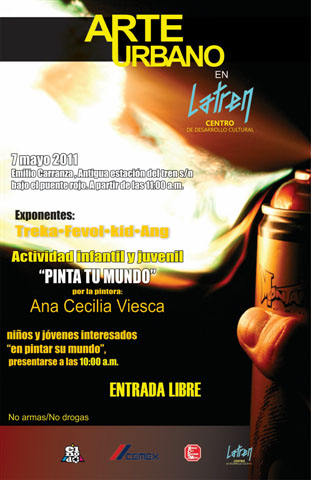


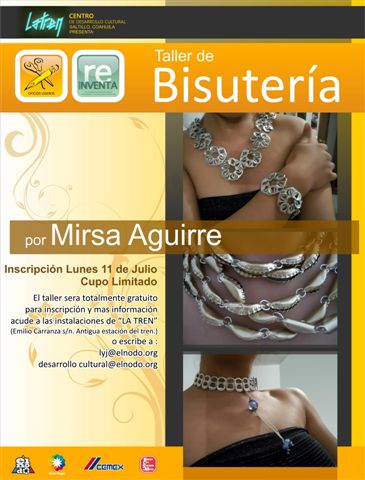
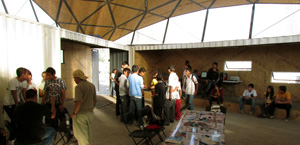 Those interested in the schedule of upcoming activities and workshops will found it in elNodo official website.
Those interested in the schedule of upcoming activities and workshops will found it in elNodo official website.
Over the years different events related to urban arts and sports such as skateboarding or graffiti competitions were organized, contributing the approach of the younger to the center and their contact with its offers or other activities aimed to rehabilitate specific spaces such as the landscaped yard of the station or realization of the graffiti in its exterior sidewall.
In 2011 the constructive goal was to equip the outdoor areas and begin the rehabilitation of the whole station building, but especially the implementation of a guests residence from the recovery of the small hotel that the station had, being this an essential tool to develop a more varied cultural program, offering the ability to host foreign teachers 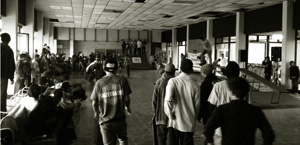 in his own facilities without having to face the costs of an external solution.
in his own facilities without having to face the costs of an external solution.
Just as in the first phase, was aimed that the creation of the residences could be the pretext for the development of workshops, so that the various operations, necessary for its rehabilitation, would allow them to advance in the training program already started with the first workshops of selfconstruction, with direct benefits in the employment conditions of the involved youth.
In 2012 the colonization of the outer space of the station was began with the creation of a “Media Lab” at ground floor, space that can also be used as a teaching classroom for other activities, and a recording studio, implemented  with shipping container at first floor, also used for a local radio transmission.
with shipping container at first floor, also used for a local radio transmission.
In general, as reported on the official website, the philosophy of these new facilities remains faithful to the original project, being to “provide members with the use of space and tools to research, develop and produce their own projects“.
ATTENTION: This short film was realized by Dan Rodríguez of Bestia Films.
2015 Evaluation
Five years after the beginning of this fantastic adventure we can now look back and analyze the project with the proper distance from the emotional processes that the process of creation of the center had involved.
Our work was focused on empowerment, provide the local team with the necessary specific tools to develop a long-term process in various aspects that compose it.
Thus the main objective of building the first equipment, besides equip the center of a physical space, was to serve as a tool, as a test, to learn and experiment propaedeutic work schemes for the commissioning of a solid and long lasting sociocultural project and the creation of a mental space that gravitates around the proposal. Its successful management and the implementation of new construction phases, completely independently of us, and with partially different schemes from the ones proposed in the first phase, certify our work demonstrating that has empowered the local community giving it development, resilience and not the dependence that often come along this kind of processes.
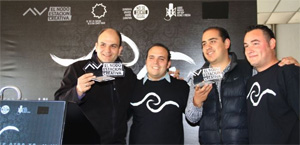
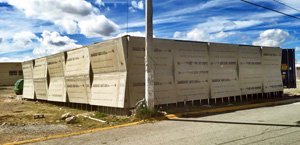

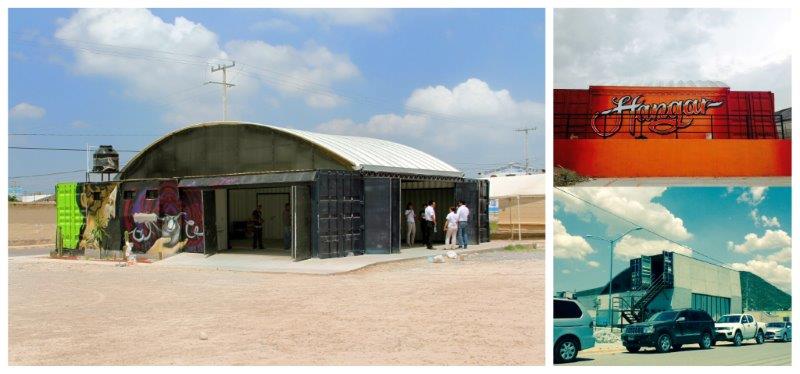
The news we receive are welcomed with great satisfaction and certainly exceed expectations and awaited results. Those are the fruit of the hard work performed by Fernando Carrera and the elNodo team over the years earning the attention and recognition of different institutions at national and international level, and also where it is more complicated: locally.
Prove of this is that in 2015 is scheduled the building of four other “nodo” cultural centers, with similar characteristics, that will bring their sociocultural programs to different neighborhoods of Saltillo.
From the personal point of view I’d wish to thank Fernando to have believed and counted on me for this project, giving me the opportunity to get involved and closer to the reality of the different socio-cultural components that actively participated in its creation, deepening their relationships and redefining my role as an architect several times throughout the process.
The process was long, in my case quite a marathon of almost twenty months in which we passed trough very difficult times, in which the goal seemed unattainable, in which all efforts seemed futile. In those moments, that now seem so distants and almost anecdotals, was essential to continue believing in the project and the presence of such good companions, with whom share up each other energies and illusions when someone seemed to be in needs.
In my case was fundamental the presence, until it lasted, of Jaime who helped me to focus on what worked and not on what did not. Of Dulce always supporting. But most all of Fernando whose firm belief in the need and the opportunity of the project never came down and and with who we achieved get along even in the most difficult moments. I think he deserve all the success he’s obtaining and wish him, and the whole elNodo team, much more with the new initiatives they are promoting.
Newspaper archive and Videography
The center’s creation process, the initiatives promoted by the people who participated in it, as well as the role of the space itself as a place of opportunities for the local socio-cultural scene, have had several occasions of visualization both in the press and in audiovisual pieces, we report some of them:
20 Enero 2019 La Vanguardia – ‘Notes & Memories’ combinan pasiones en vídeo musical
12 Octubre 2018 La Vanguardia – Crew Tripulaczion, apoyan el arte urbano
15 Octubre 2018 El Diario de Coahuila – Buscan rescatar terrenos aledaños al ferrocarril
8 Octubre 2016 La Vanguardia – Arte urbano, ¿delito o libertad de expresión?
25 Julio 2015 Zocalo – Colectivos saltillenses: El arte los une
02 Julio 2015 Zócalo – El Nodo impulsa creadores/a>
18 Noviembre 2014 Milenio – Combatirán las drogas con 4 Centros de Arte
14 Julio 2014 Zócalo – Llevarán Nodos a colonias inseguras
12 Maggio 2014 La Vanguardia – Nodo Ferroviario resurgirá de las cenizas
19 Diciembre 2013 El Diario de Coahuila – Reconoce Jericó trabajo de El Nodo
20 Julio 2013 El Heraldo de Saltillo – Impartirá “El Nodo” diplomados para jóvenes
11 Julio 2013 La Vanguardia – ‘La Tren’ galería de arte ‘a toda máquina’
14 Dicembre 2012 Zocalo – Reconoce Jericó a jóvenes
13 Dicembre 2012 Zocalo – Se reúne Jericó Abramo con ‘El Nodo’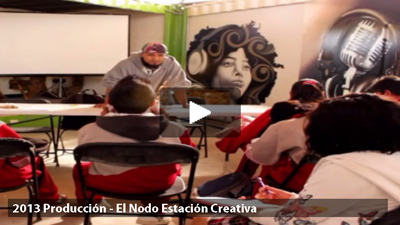
18 julio 2012 Zocalo – Destinan recursos de Subsemun a jóvenes
07 julio 2012 La Vanguardia – El Nodo, sueño urbano de creatividad
11 febrero 2011 Milenio – Sensibilizan a policías para que entiendan la ciudad
29 julio 2011 La Vanguardia – La rescatan y dan vida a la estación del tren en Saltillo
29 julio 2011 – Vías para artes y oficio
31 julio 2011 La Vanguardia – ‘La Tren’: Exponen su arte urbano en Saltillo
24 julio 2011 El Heraldo de Saltillo – Renace estación del tren para producción cultural
12 junio 2010 La Vanguardia – Estación de FFCC será Centro Cultural
13 mayo 2010 La Vanguardia – Libertad en Aerosol
12 Agosto 2009 Zocalo – Inauguran foro urbano
09 Agosto 2009 La Vanguardia – Se proponen crear espacios adecuados en Saltillo
29 Julio 2009 La Vanguardia – Darán forma a ‘Ciudad X’
Videos produced during the first Documentary Workshop directed by Guillermo Cruz (2010):
Acknowledgements
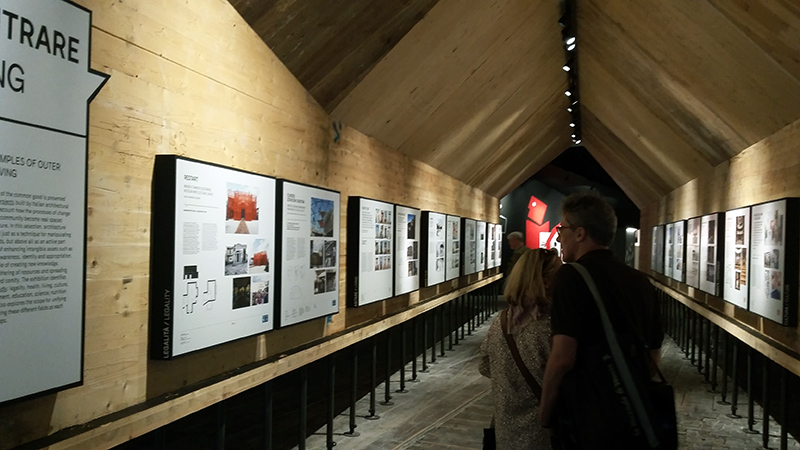 The activities organized by the team that manages the Cultural Center elNodo have positively influenced their environment by providing training and opportunities to part of that talent and local creativity that didn’t find places to express themselves and carrying out parallel activities focused on social issues aimed at the inhabitants of the surrounding neighborhoods.
The activities organized by the team that manages the Cultural Center elNodo have positively influenced their environment by providing training and opportunities to part of that talent and local creativity that didn’t find places to express themselves and carrying out parallel activities focused on social issues aimed at the inhabitants of the surrounding neighborhoods.
At the local level, the initiative as a whole has been recognised as a “Promisory Practice” by the National Centre for Crime Prevention and Citizen Participation (CNPDyPC) and the Programme for Citizen Coexistence (PCC) of Mexico, while at the international level it has been recognised as a “Good Practice” by the Dubai International Award for Best Practices / United Nations Human Settlements Programme.
ElNodo has been an integral part of the winning bidding of the “Premio eme3_2010” of the Fondazione Jesus Serra (Barcelona), in 2016 of the official exhibition of the Italian Pavilion for the XV Venice Biennale of Architecture and the process of its creation has been the subject of articles in serveral specialized international magazines.
